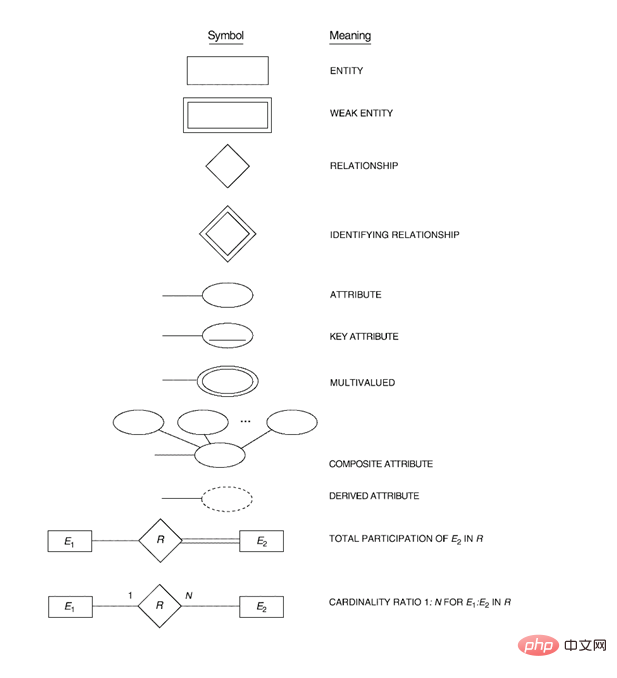
Basic knowledge points on database principles include: 1. Two-level mapping and physical and logical independence of the database system; 2. The difference between controlled redundancy and non-controlled redundancy; 3. The difference between relationships and files or tables ; 4. Relational algebra; 5. Database paradigm, etc.

##More related free learning recommendations: mysql tutorial(Video)
The basic knowledge points of database principles are:
Relational model
3. Physical model (Physical): The physical storage method of data in specific DBMS products
2. Conceptual Schema: (Also called global schema.) Sometimes referred to as "schema". It is a
description of the logical structure and characteristics of all data in the database3. External Schema
s): (also called sub-schema or user schema. )Description of the logical structure and characteristics of local data that database users can see and use
Two-level mapping and physical and logical independence of the database system:1. Conceptual schema/internal schema mapping
2.External schema/conceptual schema mapping
Physical independence of data:
The mapping between the internal schema and the conceptual schema provides the physical independence of the data. When the physical structure of the data changes, only the mapping between the internal schema and the conceptual schema needs to be modified.
Logical independence of data:
The mapping between the conceptual schema and the external schema provides the logical independence of the data. When the overall logical structure of the data changes, only the mapping between each external schema and the conceptual schema needs to be modified to ensure that the application is not affected.
Data constraints: integrity constraints2. Key constraints: each Each relationship must have a primary key, and each primary key must be different
3. Non-null constraint: attribute value cannot be NULL
4. Entity integrity constraint: primary key value cannot be null
5. Referential integrity constraints: The foreign key can take a NULL value, but if the foreign key is the primary key of another relationship, it cannot be NULL.
6. User-defined integrity
Various data operations may violate's integrity constraints
Insertion operations: domain constraints, key constraints, Non-null constraints, entity integrity constraints, referential integrity constraints
Delete operations: referential integrity constraints
Update operations: domain constraints, key constraints, non-null constraints, entity integrity constraints, Referential integrity constraints
1. FROM clause assembles data from different data sources
2. WHERE clause Filter records based on specified conditions
3. GROUP BY clause divides data into multiple groups
4. Use aggregate functions for calculation
5. Use HAVING Clause filter grouping
6. Calculate all expressions
7. Use ORDER BY to sort the result set
Uncontrolled data storage redundancy will cause the following problems:
1. Duplicate work when updating data
2. Waste of space
3. Data may be inconsistent
So, ideally, we should design a database without redundancy, but sometimes we need to improve the query Efficiency, so we introduced Controlled Redundancy
For example:
We redundantly store student names and course numbers in the GRADE_REPORT table, because when querying scores we need to query them at the same time Student name and course number.
Relationship looks like a two-dimensional table
Relationship The domain (the value range of the attribute) is a set of atomic values (non-redivisible values)
The tuples in the relationship must be different
Five basic operations: union, difference, Cartesian product, selection, projection
Relational algebra interpreter: Relational algebra interpreter (simulating relational algebra)
Inner join Types:
1. Equivalent join
2. Unequal join
3. Natural join
Copy of table structure (excluding relationships between tables)
SELECT * INTO COPY_DEPARTMENT FROM DEPARTMENT WHERE 1=0;
1. TRUE
2. FALSE
3. UNKNOWN
It is only determined to be true if the comparison result is TRUE, e.g. ( The intersection of TRUE and UNKNOWN is UNKNOWN, and this tuple will not appear in the result)
Phases of Database Design andImplementation Process( The basic process of database design)
Phase 1:Requirements Collections and Analysis(requirements collection and analysis)
Phase 2:Conceptual Database Design(conceptual structure design)
Phase 3 :Choice of a DBMS(choose the appropriate DBMS)
Phase 4:Data Model Mapping (Logical Database Design)(logical structure design)
Phase 5:Physical Database Design(physical structure design)
Phase 6:Database System Implementation(database implementation)
Phase 7:Database System Operation and Maintenance(database operation and maintenance)

1. Mapping strong entity type
2. Mapping weak entity type
3. Mapping 1: 1 binary relationship type
4. Mapping 1: N binary relationship type
5. Mapping M : N-binary relationship
6. Mapping multi-valued attributes
7. Mapping N-ary relationship
1NF (First Normal Form): If and only if all fields contain only atomic values, that is, each component is an irreducible data item, then the entity E is said to satisfy the first normal form
2NF (Second Normal Form): If and only if entity E satisfies the first normal form, and each non-key attribute completely depends on the primary key, it satisfies the second normal form
3NF (Third Normal Form): If and only if the entity E is the first normal form When it is in second normal form (2NF) and there is no non-primary attribute transitive dependency in E, it satisfies the third normal form
The above is the detailed content of What are the basic knowledge points of database principles?. For more information, please follow other related articles on the PHP Chinese website!